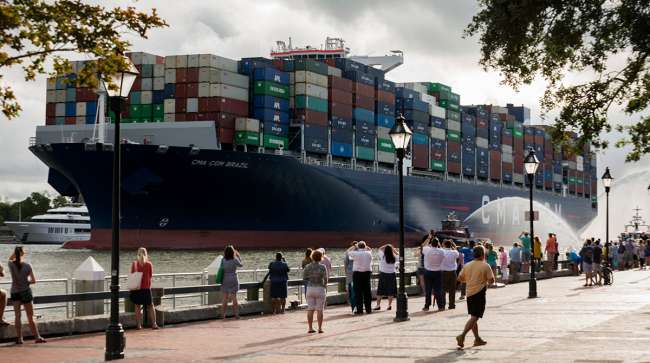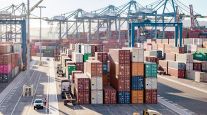Senior Reporter
Nation’s Ports Show Signs of Recovery as Imports Surge

[Stay on top of transportation news: Get TTNews in your inbox.]
The Port of Los Angeles, the nation’s busiest seaport, hit an all-time record in August, processing 12% more volume that totaled 961,833 20-foot-equivalent units (TEUs).
The increase was driven by imports, which eclipsed 500,000 TEUs for the first time.
“In May we saw our lowest container volumes in more than a decade,” said Gene Seroka, executive director at the Port of Los Angeles. “Since then, there has been a significant replenishment of warehouse inventories. Coupled with retailers planning for consumer holiday spending, it has created a surge of imports.”
The Port of Los Angeles processed 961,833 Twenty-Foot Equivalent Units (TEUs) in August, the first monthly cargo increase in a year. The 12% gain in cargo was driven by imports, which eclipsed 500,000 TEUs for the first time. https://t.co/Na3UjXmEu3 pic.twitter.com/xzAYRMTZUC — Port of Los Angeles (@PortofLA) September 15, 2020
The overall gain is up from 861,080 TEUs in August last year.
However, the coronavirus pandemic that struck the United States in March — just behind scheduled factory closures in China for New Year’s celebrations — caused an 11.7% drop in year-to-date cargo volume.
By segment, August loaded imports increased 18% to 516,286 TEUs from last year. Loaded exports decreased 10.2% to 131,429 TEUs. Empty containers increased 13.3% to 314,118 TEUs.
Neighboring Port of Long Beach also had a record-breaking August, processing 725,610 TEUs, a 9.3% increase compared with 663,993 TEUs a year ago.
But port officials are cautious.
“Despite the recent surge in cargo, uncertainty remains in international trade and the national economy, given the ongoing COVID-19 impacts,” said Mario Cordero, Long Beach executive director.
Up the coast, the Port of Oakland reported August cargo volume was 225,456 TEUs compared with 224,535 a year ago, a difference of .4% or 921 containers.
Port of Oakland import volume up for third straight month;
entering peak shipping season, exports also up https://t.co/yWosHVXvwF #maritime #cargovolume #cargo #ports #logistics #shipping pic.twitter.com/WKtHdeMnz5 — Port of Oakland (@PortofOakland) September 17, 2020
Port of Oakland officials viewed the small gain as encouraging because August represented a turnaround, especially when it comes to imports. Imports rose for the third straight month, jumping 9%.
As peak holiday season gets underway, port officials were hopeful. Aside from retail goods, also pushing cargo volume up was an increase in medical supplies as hospitals and clinics restocked protective equipment.
“We’re waiting to see how COVID-19 will affect our retail partners,” Port of Oakland Maritime Director Bryan Brandes said.
The Northwest Seaport Alliance, which operates in Seattle and Tacoma, was the only West Coast port not to report a year-over-year increase, despite imports surging to a yearly high.
Overall, the ports processed 276,407 TEUs in August, a 13.8% decline compared with last year’s 320,564 containers.
The complex experienced 58 blank sailings through August — equal to all of 2019 — officials said.
On the East Coast, Port of Savannah notched an all-time record in August after a .9% year-over-year increase to 441,586 TEUs from 437,747 in the same month a year ago. It was the first time in the port’s history it had cracked the 440,000 TEU mark.
On Sept. 18, the port welcomed the CMA CGM Brazil, one of the largest ships with a capacity of 15,072 TEUs.

Home | Video | Heroes' Photo Gallery
Saluting the men and women of the trucking industry who kept America's essential goods flowing during the coronavirus pandemic.
Heroes: Peter Lacoste | Susan Dawson | James Rogers | Reggie Barrows | Kevin Cooper | Cesar Quintana Moreno
The South Carolina Ports Authority, which operates the Port of Charleston, reported its two container terminals saw a 10.4% decline year-over-year in August. It processed 208,837 TEUs, compared with 233,110 a year ago. Despite the decrease, when measured against last August, port officials were optimistic.
“Our August volumes surpassed expectations, reflecting the best year-over-year month since the pandemic began impacting global supply chains in March,” South Carolina Ports CEO Jim Newsome said.
In the Gulf of Mexico, Port of Houston reported a 4% year-over-year decline in August as it processed 248,630 TEUs, compared with 259,110 a year ago. Still, port officials are hopeful.
“We’ve seen a large number of extra loaders this peak season as retailers in our region replenish inventories, and those extra loaders have helped balance the impact of blank sailings,” said Roger Guenther, executive director at Port of Houston.
Want more news? Listen to today's daily briefing:
Subscribe: Apple Podcasts | Spotify | Amazon Alexa | Google Assistant | More




